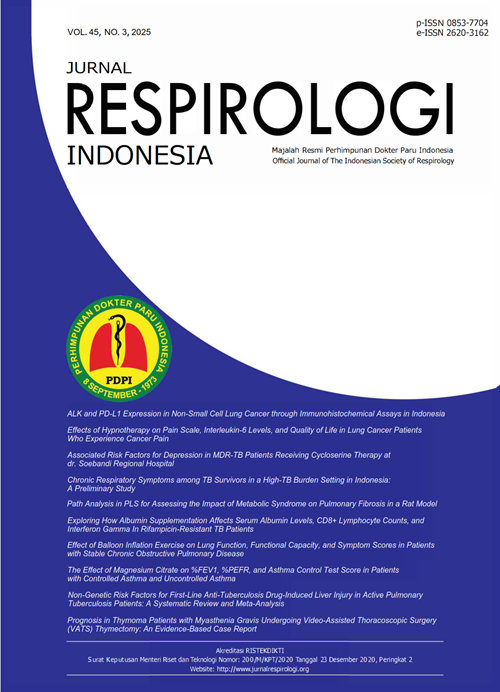Effect of Balloon Inflation Exercise on Lung Function, Resilience, and Quality of Life in Patients Stable Copd RS UNS
DOI:
https://doi.org/10.36497/jri.v45i3.492Keywords:
%VEP1, Borg scale, CAT, EID, training capacityAbstract
Background: His WHO data for 2019 puts him third in COPD deaths, at about 3.23 million. Decreased respiratory function is one of the symptoms of COPD that causes respiratory arrest that impacts quality of life. Pulmonary rehabilitation in COPD patients is a means of controlling and reducing symptoms and optimizing functional function.
Method: Experimental study with pre-test and post-test groups design. The number of study participants was 30 stable COPD outpatient in group B and E of the Respiratory Clinic of the UNS Hospital during the period of February 2023 by targeted sampling. The control group (n = 15) received standard care and the treatment group (n=15) received standard care plus additional balloon-inflation exercises for 6 weeks. Comparisons between pretest and posttest groups were made on %VEP1 score, breathlessness symptoms, CAT questionnaire, exercise capacity, and EID.
Result: Increased values of %VEP1 (p=0.001), decreased Borg scale (p=0.001), decreased CAT score (p = <0.001), and physical activity performance (p = 0.001) versus his EID (p = <0.001) increase.
Conclusion: Inflating the balloon affects %VEP1, Borg scale, CAT score, training capacity increase, and EID values. Balloon blowing exercise increases the %VEP1 value, lowers the Borg scale, lowers the CAT score, increases exercise capacity, and EID.
Keywords: %VEP1, Borg scale, training capacity, CAT, EIDDownloads
References
1. Perhimpunan Dokter Paru Indonesia. Penyakit paru obstruktif kronik (PPOK) diagnosis dan penatalaksanaan. 1st ed. Antariksa B, Susanthy D, Wiyono WH, Sutoyo DK, Damayanti T, Syafiuddin T, et al., editors. Jakarta: UI Press; 2016. 1–88 p.
2. Agustí A, Beasley R, Celli BR, Chen R, Criner G, Halpin D, et al. Global initiative for chronic obstructive lung disease. Global strategy for the diagnosis, management, and prevention of chronic obstructive pulmonary disease. European Respiratory Journal. 2022;61:4–95.
3. World Health Organization. Chronic obstructive pulmonary disease (COPD) [Internet]. 2021 [cited 2021 Jun 21]. Available from: https://www.who.int/news-room/fact-sheets/detail/chronic-obstructive-pulmonary-disease-(copd)
4. Szalontai K, Gémes N, Furák J, Varga T, Neuperger P, Balog J, et al. Chronic obstructive pulmonary disease: Epidemiology, biomarkers, and paving the way to lung cancer. J Clin Med. 2021;10(13):2889.
5. Li J, Lu Y, Li N, Li P, Su J, Wang Z, et al. Muscle metabolomics analysis reveals potential biomarkers of exercise-dependent improvement of the diaphragm function in chronic obstructive pulmonary disease. Int J Mol Med. 2020;45(6):1644–60.
6. Luis F, Moncayo G. Overview of the respiratory system: function and structure. In: Cloutier MM, editor. Respiratory physiology (mosby physiology series). Philadelphia: Elsevier; 2007. p. 1–13.
7. Ceriana P, Vitacca M, Carlucci A, Paneroni M, Pisani L, Nava S. Changes of respiratory mechanics in COPD patients from stable state to acute exacerbations with respiratory failure. COPD: Journal of Chronic Obstructive Pulmonary Disease. 2017;14(2):150–5.
8. Jimborean G, Ianosi ES, Croitoru A, Szasz S, Postolache P. Respiratory muscle training in chronic obstructive pulmonary disease. Pneumologia. 2017;66(3):128–30.
9. Wright JL, Churg A. Pathology of chronic obstructive pulmonary disease: Diagnostic features and differential diagnosis. In: Grippi MA, Antin-Ozerkis DE, Cruz CS Dela, Kotloff RM, Kotton CN, Pack AI, editors. Fishman’s Pulmonary Diseases and Disorders. 6th ed. New York: McGraw-Hill Education.; 2015. p. 600–13.
10. Eschenbacher WL. COPD recognition and diagnosis: approach to the patient with respiratory symptoms. In: Panos RJ, Eschenbacher WL, editors. A COPD primer. Berlin: De Gruyter; 2015. p. 31–40.
11. Charususin N, Dacha S, Gosselink R, Decramer M, Von Leupoldt A, Reijnders T, et al. Respiratory muscle function and exercise limitation in patients with chronic obstructive pulmonary disease: A review. Expert Rev Respir Med. 2018;12(1):67–79.
12. Grznár Ľ, Sucháň D, Labudová J, Odráška L, Matúš I. Influences of breathing exercises and breathing exercise combined with aerobic exercise on changes in basic spirometry parameters in patients with bronchial asthma. Applied Sciences (Switzerland). 2022;12(14):7352.
13. García-Talavera I, Figueira-Gonçalves JM, Gurbani N, Pérez-Méndez L, Pedrero-García A. Clinical characteristics of COPD patients with early-onset desaturation in the 6-minute walk test. Pulmonology. 2018;24(5):275–9.
14. Liu SF, Chin CH, Tseng CW, Chen YC, Kuo HC. Exertional desaturation has higher mortality than non-desaturation in COPD. Medicina (Lithuania). 2021;57(10):1110.
15. Waatevik M, Frisk B, Real FG, Hardie JA, Bakke P, Nilsen RM, et al. One year change in 6-minute walk test outcomes is associated with COPD prognosis. COPD: Journal of Chronic Obstructive Pulmonary Disease. 2020;17(6):662–71.
16. Gupta R, Ruppel GL, Espiritu JRD. Exercise induced oxygen desaturation during the 6-minute walk test. Med Sci (Basel). 2020;8(1):8.
17. Celli BR. Management guideline for chronic obstructive pulmonary dissease. In: Hanania NA, Sharafkhaneh A, editors. COPD: A guideline to diagnose and clinical management. New York: Humana Press; 2011. p. 81–98.
18. Tunik, Niningasih R, Yuswantoro E. The effectiveness of breath relaxation with balloon blowing technique towards oxygen saturation of COPD patients. Jurnal Pendidikan Kesehatan. 2017;9(2):193–9.
19. Basso-Vanelli RP, Pires di Lorenzo VA, Labadessa IG, Regueiro EMG, Jamami M, Gomes ELFD, et al. Effects of inspiratory muscle training and calisthenics-and-breathing exercises in COPD with and without respiratory muscle weakness. Respir Care. 2016;61(1):50–60.
20. Kosayriyah SD, Hafifah VN, Munir Z, Rahman HF. Analisis efektifitas pursed lip breathing dan balloon blowing untuk meningkatkan saturasi oksigen pada pasien COPD (chronic obstructive pulmonary disease). Jurnal Sains dan Kesehatan. 2021;3(2):328–34.
21. Suharno MD, Sudiana IK, Dian NK, Bakar A, Amin M, Sukartini T, et al. The effectiveness of ballon blowing exercise on increasing expiratory forced volume value in 1 second (FEV1) and oxygen saturation among COPD patients. International Journal of Nursing and Health Services (IJNHS). 2020;3(4):513–9.
22. Mentariningrum IF. Pengaruh home based pulmonary rehabilitation (HBPR) jenis latihan penguat otot quadriceps dan pulsed lip breathing terhadap kekuatan otot quadriceps, VO2 max, gejala sesak napas, kapasitas exercise, dan skor XAT penderita PPOK stabil. [Surakarta]: Universitas Sebelas Maret; 2020.
23. Raharjo AM. Pengaruh latihan harmonika pada kapasitas inspirasi, gejala sesak napas, kapasitas latihan, dan kualitas hidup penderita penyakit paru obstruksi kronis. [Surakarta]: Universitas Sebelas Maret; 2017.
24. Adhika R. Pengaruh pemberian rofumilast terhadap jumlah neutrofil absolut darah, matrix metalloproteinase 9 serum, nilai %VEP1, dan skor CAT penderita PPOK stabil. [Surakarta]: Universitas Sebelas Maret; 2020.
25. Furulund E, Bemanian M, Berggren N, Madebo T, Rivedal SH, Lid TG, et al. Effects of nutritional interventions in individuals with chronic obstructive lung disease: A systematic review of randomized controlled trials. Int J Chron Obstruct Pulmon Dis. 2021;16:3145–56.
26. Corcioli AC, Pessoa-Santos BV, Takara GN, Lorenzo VAP Di, Jamami M. Reported dyspnea and fatigue using different scales during the physical effort in COPD. Fisioterapia em Movimento. 2017;30(2):207–17.
27. Jun HJ, Kim KJ, Nam KW, Kim CH. Effects of breathing exercises on lung capacity and muscle activities of elderly smokers. J Phys Ther Sci. 2016;28(6):1681–5.
28. Junaidin. Perbandingan latihan pursed lip breathing dan meniup balon terhadap respiratory rate pada pasien penyakit paru obstruksi kronis di balai besar kesehatan paru masyarakat Makassar. Nursing Inside Community Journal. 2020;2(2):42–50.
29. Rafaqat A, Mushtaq Z. Comparison between balloon blowing exercise and incentive spirometry in patients with chest intubation after trauma. J Nov Physiother. 2016;3:S3.
30. Ramsook AH, Molgat-Seon Y, Schaeffer MR, Wilkie SS, Camp PG, Reid WD, et al. Effects of inspiratory muscle training on respiratory muscle electromyography and dyspnea during exercise in healthy men. J Appl Physiol. 2017;122(5):1267–75.
31. Yekefallah L, Zohal MA, Keshavarzsarkar O, Barikani A, Gheraati M. Comparing the effects of upper limb and breathing exercises on six-minute walking distance among patients with chronic obstructive pulmonary disease: A three-group randomized controlled clinical trial. Adv Respir Med. 2019;87(2):77–82.
32. Mulyadi, Junita IM, Zulfikar T, Yusuf N, Azhary M, Salim HM. The effect of pursed-lips breathing and diaphragm exercises on the quality of life of COPD patient assessed by six-minutes walk test. Bali Medical Journal. 2022;11(3):1116–20.
33. Welch JF, Kipp S, Sheel AW. Respiratory muscles during exercise: Mechanics, energetics, and fatigue. Curr Opin Physiol. 2019;10:102–9.
34. Lee JH. Pathogenesis of COPD. In: Lee SD, editor. COPD heterogeneity and personalized treatment. 1st ed. Berlin: Springer; 2017. p. 35–46.
Downloads
Published
Issue
Section
License
Copyright (c) 2025 Atmasari Pratiwi, Hendrastutik Apriningsih, Ana Rima Setijadi, Artrien Adhiputri, A. Farih Rahardjo

This work is licensed under a Creative Commons Attribution-ShareAlike 4.0 International License.
- The authors own the copyright of published articles. Nevertheless, Jurnal Respirologi Indonesia has the first-to-publish license for the publication material.
- Jurnal Respirologi Indonesia has the right to archive, change the format and republish published articles by presenting the authors’ names.
- Articles are published electronically for open access and online for educational, research, and archiving purposes. Jurnal Respirologi Indonesia is not responsible for any copyright issues that might emerge from using any article except for the previous three purposes.
















